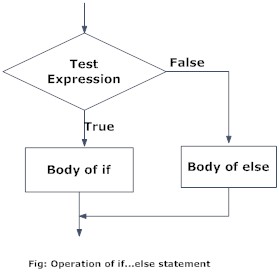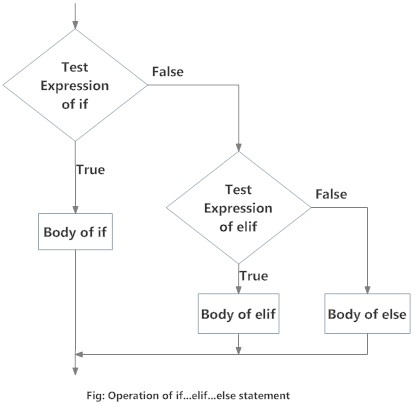- C if … else语句
- C if … else语句(1)
- JavaScript if … else语句
- JavaScript-if … else语句
- JavaScript if … else语句(1)
- JavaScript-if … else语句(1)
- Java if,if … else语句(1)
- Java if,if … else语句
- Swift if,if … else语句
- Swift if,if … else语句(1)
- C#if,if … else,if … else if和嵌套if语句(1)
- C#if,if … else,if … else if和嵌套if语句
- C++ if,if … else和嵌套if … else(1)
- C++ if,if … else和嵌套if … else
- Perl条件语句-IF … ELSE
- Perl条件语句-IF … ELSE(1)
- Perl条件语句-IF … ELSE(1)
- Perl条件语句-IF … ELSE
- MATLAB if-else …结束语句
- MATLAB if-else …结束语句(1)
- Python中If-else语句
- Python中If-else语句(1)
- if else 语句 c# (1)
- R – if-else 语句
- R – if-else 语句(1)
- C#– if else语句
- IF else 语句 (1)
- C if else语句
- R If else语句(1)
📅 最后修改于: 2020-09-19 13:56:59 🧑 作者: Mango
在本文中,您将学习使用不同形式的if..else语句在Python程序中创建决策。
if … else Python语句是什么?
仅当满足特定条件时,才需要执行代码时才需要决策。
if…elif…else语句在Python用于决策。
Python if语句语法
if test expression:
statement(s)在此,程序将评估test expression并且仅在测试表达式为True时才执行语句。
如果测试表达式为False ,则不执行该语句。
在Python, if语句的主体由缩进指示。主体以缩进开始,第一条未缩进的线标记结束。
Python将非零值解释为True 。 None和0被解释为False 。
Python if语句流程图

示例: Python if语句
# If the number is positive, we print an appropriate message
num = 3
if num > 0:
print(num, "is a positive number.")
print("This is always printed.")
num = -1
if num > 0:
print(num, "is a positive number.")
print("This is also always printed.")运行该程序时,输出为:
3 is a positive number
This is always printed
This is also always printed.在上面的示例中, num > 0是测试表达式。
if的主体只有在其值为True时才执行。
当变量num等于3时,测试表达式为true,并且执行if体内的语句。
如果变量num等于-1,则测试表达式为false,并且if体内的语句将被跳过。
print()语句位于if块之外(未缩进)。因此,无论测试表达式如何,都将执行它。
Python if … else语句
if … else的语法
if test expression:
Body of if
else:
Body of else该if..else语句计算test expression和将要执行的主体if只有当测试条件为True 。
如果条件为False ,则执行else的主体。缩进用于分隔块。
Python if..else流程图

if … else的示例
# Program checks if the number is positive or negative
# And displays an appropriate message
num = 3
# Try these two variations as well.
# num = -5
# num = 0
if num >= 0:
print("Positive or Zero")
else:
print("Negative number")输出
Positive or Zero在上面的示例中,当num等于3时,测试表达式为true,并且if的主体被执行,else的body被跳过。
如果num等于-5,则测试表达式为false,并且执行else的主体, if的主体被跳过。
如果num等于0,则测试表达式为true,并且if正文被执行,else的body被跳过。
Python if … elif … else语句
if … elif … else的语法
if test expression:
Body of if
elif test expression:
Body of elif
else:
Body of else elif是if的缩写。它允许我们检查多个表达式。
如果条件为if是False ,它会检查下一个条件elif块等。
如果所有条件均为False ,则执行else的主体。
根据条件只执行几个if...elif...else块中的一个块。
if块只能有一个else块。但是它可以有多个elif块。
if … elif … else的流程图

if … elif … else的示例
'''In this program,
we check if the number is positive or
negative or zero and
display an appropriate message'''
num = 3.4
# Try these two variations as well:
# num = 0
# num = -4.5
if num > 0:
print("Positive number")
elif num == 0:
print("Zero")
else:
print("Negative number")当变量num为Positive number将打印Positive number 。
如果num等于0,则打印Zero 。
如果num为负数,则打印Negative number 。
Python嵌套if语句
我们可以有一个if...elif...else内另一份声明中if...elif...else说法。这在计算机编程中称为嵌套。
这些语句中的任何数目都可以彼此嵌套。缩进是弄清楚嵌套级别的唯一方法。它们可能会造成混乱,因此除非有必要,否则必须避免使用它们。
如果示例嵌套Python
'''In this program, we input a number
check if the number is positive or
negative or zero and display
an appropriate message
This time we use nested if statement'''
num = float(input("Enter a number: "))
if num >= 0:
if num == 0:
print("Zero")
else:
print("Positive number")
else:
print("Negative number")输出1
Enter a number: 5
Positive number输出2
Enter a number: -1
Negative number输出3
Enter a number: 0
Zero